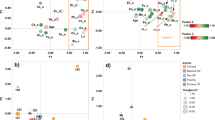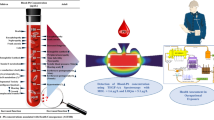Summary
The oxide of trivalent antimony is used in the glass-producing industry as a refining agent and as a glass colouring. The batch contains up to 2% Sb2O3, a substance which has shown carcinogenic properties in animal experiments. The internal levels of antimony and lead in blood (SbB and PbB) as well as the excretion with the urine (SbU and PbU) were determined by hydrid and electrothermal atomic absorption (HY-AAS and ET-AAS), respectively. In addition, measurements of airborne Sb2O3-concentrations were performed. The 109 volunteers were employed in four different fields: melting area, batch bunker, glass-washing area, and transport/maintenance. Differences between the concentrations of antimony and lead in blood and urine with respect to the fields of activity were evaluated statistically. The highest values of airborne Sb2O3 with up to 840 μg/m3 (TWA), were detected in the batch bunker. Correspondingly, significantly enhanced SbU-values from 1.5 to 15.7 μg/l (median: 5.0 μg/l were found in specimens collected from the batch mixers. In the same group, the lead excretion (PbU) with values from 9 to 110 μg/l (median: 43 μg/l) was also found to be the highest. Due to the fast renal excretion of antimony, the determination of SbU is useful for biological monitoring.
Similar content being viewed by others
References
Bencze K (1981) Bestimmung von Antimon im Vollblut als Hydrid in dreiwertiger Form mit Hilfe von Atom-Absorptions-Spektroskopie (AAS). Ärztl Lab 27:347–351
Der Bundesminister für Arbeit und Sozialordnung (ed. 1984) Ausschuß für gefährliche Arbeitsstoffe: technische Regeln für gefährliche Arbeitsstoffe (TRgA 402). Bundesarbeitsblatt 11:55–61
Deutsche Forschungsgemeinschaft (ed. 1986) Maximale Arbeitsplatzkonzentrationen und biologische Arbeitsstofftoleranzwerte. Verlag Chemie, Weinheim
Elinder C-G, Friberg L (1986) Antimony. In: Friberg L, Nordberg G, Vouk V (ed) Handbook on the toxicology of metals, vol 2, 2nd edn. Elsevier/North-Holland Biomedical Press, Amsterdam
Günther R, Löffler H, Weyl WA (1957) Glas. In: Foerst W (ed) Ullmann's Encyklopädie der technischen Chemie, vol 8, 3rd edn. Urban and Schwarzenberg, München
Henschler D (1983) Gesundheitsschädliche Arbeitsstoffe — Toxikologisch-arbeitsmedizinische Begründung von MAK-Werten. Loseblattsammlung. Verlag Chemie, Weinheim
Koch OG, Koch-Dedic GA (ed. 1974) Handbuch der Spurenanalyse, vol 2, 2nd edn. Springer, Berlin Heidelberg New York Tokyo
Lüdersdorf R, Schäcke G, Mayer P (1981) Wirkung von Einweg-Atemschutzmasken auf die Blutblei- und ALA-Konzentrationen bei Bleiglasschleifern. Zbl Arbeitsmed 31:374–380
Lüdersdorf R, Skulsuksai G, Khoury L, Schäcke G (1985) Bestimmung von Antimon im Blut. Zbl Arbeitsmed 35:314–316
McCallum RI (1977) Observations upon antimony. Proc R Soc Med 70:756–763
Stemmer KL (1976) Pharmacology and toxicology of heavy metals: antimony. Pharmacol Ther A 1:157–160
Stokinger HE (1982) The metals. In: Clayton GD, Clayton FE (eds) Patty's industrial hygiene and toxicology, vol 2, 3rd edn. Wiley and Sons, New York
Unfallverhütungsvorschrift VBG 113 (1983) Schutzmaßnahmen beim Umgang mit krebserzeugenden Arbeitsstoffen
Author information
Authors and Affiliations
Rights and permissions
About this article
Cite this article
Lüdersdorf, R., Fuchs, A., Mayer, P. et al. Biological assessment of exposure to antimony and lead in the glass-producing industry. Int Arch Occup Environ Heath 59, 469–474 (1987). https://doi.org/10.1007/BF00377841
Received:
Accepted:
Issue Date:
DOI: https://doi.org/10.1007/BF00377841




